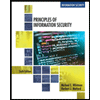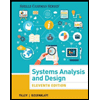
Concept explainers
Explanation of Solution
Data:
- It is the representation of objects and events which are stored and recorded in the computer.
- It exists in variety of forms such as number, value, variable, and so on.
- For example,
database in doctor’s office contains data such as patient name, address, disease, and contact number. - Data about the facts is called as structured data.
- In addition to structured data, database includes documents, e-mails, maps, images, sound and video segment called as unstructured data.
Example:
At Costco, the staff employees look for the data like how much is the item, how many items do they have in stock, when are their days off and many such things.
Information:
- These are the processed data that increase the information of the individual using it.
- Data are useless in their present form so it is preprocessed and represent it as the information to the user.
- It is converted into the meaningful form during the processing phase of the information processing cycle.
Example:
Executives at Costco need information like, are prices too high or too low, what is employee turnover per store and many such things.
Business intelligence:
Information collected from various sources to make a strategic decision in a company is called as business intelligence.
- The source of information for BI is gathered from customers, suppliers, partners, competitors, and industries.
Example:
The executives need to analyze whether the store is having enough turnover or it needs to get closed and sometimes to decide the place where a new store need to be established. All such information that helps to take a strategic decision is called business intelligence.
Knowledge:
The skills, expertise and experience of a person coupled with information and intelligence, which develops the person’s cerebral resources, is called as knowledge.
When data is moved towards knowledge, more and more variables can be included for analysis, resulting in more precise problem solving and decision making.
Example:
It is necessary for any organization to have knowledge about the current market status an even the internal matters of the organization which is also implied on Costco. It maintains its good level in the market by having updated information about the world market scenario and internal matters of Costco.
Want to see more full solutions like this?
Chapter 1 Solutions
Business Driven Technology
- What is one benefit with regards to time complexity of using a Doubly Linked List as opposed to an Array when implementing a Deque?arrow_forwardWhat is one benefit with regards to space complexity of using a Doubly Linked List as opposed to an Array when implementing a Deque?arrow_forwardWhich basic data structure (Doubly Linked List, Singly Linked List, Array) would you use to implement a Stack? Why?arrow_forward
- Did you comment all methods in the Deque class to include 1. The method's behavior 2. Arguments that are passed to the method (if any), their expected types, and what they are used for 3. What the method returns (if any) 4. A description of the behavior of each line in the methodarrow_forwardWhy use a Doubly Linked List as opposed to a Singly Linked List for a Deque?arrow_forwardthis module is java 731 , follow all instructions and make sure the outputs are like what they expect and make sure the code is 100% correct . include all comments , layout and structure to be perfect too, thanks. Question 1: E-Hailing Bicycle Management System Case Study:An e-hailing company that rents out bicycles needs a system to manage its bicycles, users, and borrowing process. Each user can borrow up to 2 bicycles at a time, specifically for families with children 18 years or below. The system must track the bicycles (name, make, type, and availability) and users (name, ID, and borrowed bicycles). The company also wants to ensure that the system uses a multidimensional array to store information about the bicycles. Requirements: Add and View Bicycles: Borrow Bicycles: Return Bicycles Display Borrowed Bicycles and Search for a bicycle Create a menu-driven program to implement the above. Sample Output: Add Bicycle View All Bicycles Borrow Bicycle Return…arrow_forward
- Add a method called transfer () to the BankAccount class, that takes in an amount and destinationAccount as input and transfer the funds from current account to destination account. This method should return the balance of the current account after the transfer, also should check for the sufficient balance in current account before proceeding the transfer and if there is insufficient balance return an error message "Insufficient balance". Modify the BankAccount Test class, so that it calls the transfer () method and prints the balance after transfer. Make sure that the transfer() method updates the balance of both the current account and the destination account.arrow_forward• Create a public method called deposit() that takes in an amount of type double as input and adds the amount to the current balance. This method should also return the updated balance. • Create another public method called withdraw() that takes in an amount of type double as input, checks if the withdrawal amount is less than the current balance, and if so, subtracts the amount from the balance. If the withdrawal amount is greater than the current balance, the method should return an error message "Insufficient balance". • Create a public method getAccountInfo() that returns the account information in the format "Account Number: xxxxx, Account Holder: John Doe, Account Type: SAVINGS/CHECKING, Balance: $xxxX.XX". • Finally, create a constructor method that takes in the account number, account holder name, initial balance and account type as input and initializes the corresponding instance variables. In the BankAccount class, make sure to use the private access modifier for the instance…arrow_forwardCreate a BankAccount Test class that contains a main() method that instantiates an object of type BankAccount, with account number of 12345, account holder name of "John Doe", initial balance of $1000 and account type as SAVINGS . Then use the deposit() and withdraw() methods of the object to deposit $500 and withdraw $300. Finally, use the getAccountInfo() method to print the current account information. Use the getAccountInfo() method to verify that the deposit and withdrawal actions are performed correctly and that the account information is updated accordingly.arrow_forward
- Add a new class checkingAccount that inherits from the BankAccount class, and has a double instance variable overdraft Limit in addition to the variables inherited from the superclass. • Create a constructor for the checking Account class that takes in the account number, account holder name, initial balance, account type and overdraft limit as input, and uses the super keyword to call the constructor of the superclass, passing in the account number, account holder name and initial balance, account type. • Re-write the withdraw() method in the checkingAccount class so that it first checks if the withdrawal amount is less than the current balance plus the overdraft limit. If it is, the withdrawal is allowed and the balance is updated. If not, the method should return an error message "Insufficient funds". • Create a new method displayOverdraft Limit() that returns the overdraft limit of the CheckingAccount . • In the BankAccountTest class, create a new object of type Checking Account…arrow_forwardExplain what the rwpos() function does. What is the base case? What values are passed to the recursive call? What value is returned by the original function call?arrow_forwardExplain what the rs() function does. What value(s) does it return? Is that value always the same? Why or why not?arrow_forward
 Management Of Information SecurityComputer ScienceISBN:9781337405713Author:WHITMAN, Michael.Publisher:Cengage Learning,
Management Of Information SecurityComputer ScienceISBN:9781337405713Author:WHITMAN, Michael.Publisher:Cengage Learning, Information Technology Project ManagementComputer ScienceISBN:9781337101356Author:Kathy SchwalbePublisher:Cengage Learning
Information Technology Project ManagementComputer ScienceISBN:9781337101356Author:Kathy SchwalbePublisher:Cengage Learning Principles of Information Systems (MindTap Course...Computer ScienceISBN:9781285867168Author:Ralph Stair, George ReynoldsPublisher:Cengage Learning
Principles of Information Systems (MindTap Course...Computer ScienceISBN:9781285867168Author:Ralph Stair, George ReynoldsPublisher:Cengage Learning Principles of Information Systems (MindTap Course...Computer ScienceISBN:9781305971776Author:Ralph Stair, George ReynoldsPublisher:Cengage Learning
Principles of Information Systems (MindTap Course...Computer ScienceISBN:9781305971776Author:Ralph Stair, George ReynoldsPublisher:Cengage Learning Principles of Information Security (MindTap Cours...Computer ScienceISBN:9781337102063Author:Michael E. Whitman, Herbert J. MattordPublisher:Cengage Learning
Principles of Information Security (MindTap Cours...Computer ScienceISBN:9781337102063Author:Michael E. Whitman, Herbert J. MattordPublisher:Cengage Learning Systems Analysis and Design (Shelly Cashman Serie...Computer ScienceISBN:9781305494602Author:Scott Tilley, Harry J. RosenblattPublisher:Cengage Learning
Systems Analysis and Design (Shelly Cashman Serie...Computer ScienceISBN:9781305494602Author:Scott Tilley, Harry J. RosenblattPublisher:Cengage Learning





